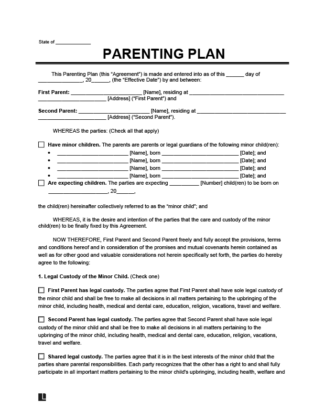
Use our parenting plan template to outline parenting arrangements for your children after separation.

Updated September 22, 2023
Written by Ioana Gagiuc | Reviewed by Brooke Davis
A parenting plan (or a “child custody agreement”) outlines the responsibilities of each parent when they’re separated or divorced.
Parenting plans are often included in a separation agreement or divorce agreement. Some parents choose to complete two separate parenting plans to submit to the court for consideration, while others work together to reach an agreement before completing and signing the plan.
A judge must approve a parenting plan that separated or divorced parents submit. They account for several factors, including the parents’ health conditions, the parents’ ability to provide basic needs, and the child(ren)’s preferences.
A parenting plan outlines how divorced or separated parents will care for their child(ren). This document can reduce parental conflicts and offer clarity by establishing parenting expectations and responsibilities.
Ultimately, the document can benefit both the parents and the child(ren), allowing them to create an ideal parenting situation that suits their circumstances.
Here’s a list of steps on how to write a parenting plan:
Fill out the parents’ names, contact information, and the child(ren)’s name and birthdate.
Later in the agreement, you and your co-parent will be referred to as “First Parent” and “Second Parent.” Your child(ren) will be called the “minor child.”
Detail the legal and physical custody arrangements for your child(ren). There are several custody options available:
You may also consider establishing bird’s nest custody. This custody arrangement is unique because the child remains in a single home while the parents switch who lives with the child. While this arrangement may be more inconvenient for the parents, it creates a stable environment for the child.
If one parent has sole or primary physical custody of the child(ren), indicate the other parent’s visitation rights.
If parents have joint physical custody, your parenting plan should include a parenting schedule that dictates which days the child(ren) will spend with each parent.
The ideal parenting schedule for your family can depend on how far apart the two parents live and how exchanges will work. Typically, in joint custody cases, the goal is to allow each parent to spend equal time with their child without disrupting their physical and emotional needs.
A few common examples of joint custody parenting schedules include:
As children grow and their needs and schedules change, you can petition the court to modify the parenting schedules accordingly.
Your parenting plan should also determine which significant holidays and school vacations the child(ren) will spend with which parent.
Co-parents can use this section to describe their rights to see their children in activities like school sports and emergencies.
Your plan should also clearly state which situations a parent must contact the other and how they will communicate the information. For example, you can outline the contact procedure if a medical decision needs to be made for the child. This section can also include any terms you want to add to the agreement based on your family’s needs.
When creating a parenting plan, include as many details as possible so both parents know exactly how they’re expected to respond in various situations.
Your parenting plan should detail the following:
If applicable, the parenting plan should include the monthly amount the noncustodial parent will pay in child support.
Check your state’s laws to determine if you need to sign the parenting plan before witnesses or a notary public.
Witnesses can help verify the agreement’s authenticity if a dispute arises, even if it’s not required.
Here are some tips for writing a parenting plan:
Creating a parenting plan in the early stages of a divorce or separation will prevent your child’s schedule from being disrupted more than necessary and benefit their overall well-being.
Although younger children might not understand separation, older children, such as teenagers, would likely want to voice their needs and preferences. It’s suggested you don’t make important decisions, such as where they’ll spend Christmas, without them.
Specifying a method of communication, such as via an online platform, can be helpful when you need to discuss issues or share schedules and calendars. You can centralize your discussions by determining where communications will occur, which will be essential to refer to in court if an issue arises.
Review our parenting plan template and download it as a PDF or Word file below: